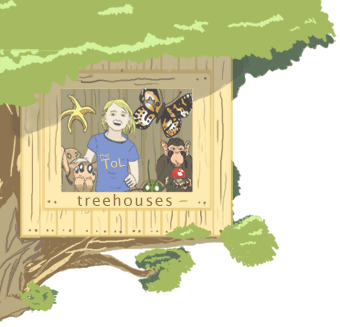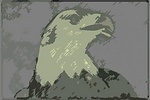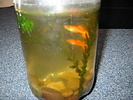Treehouses on the Tree of Life
Browse the Site
Browse Sample Treehouses

Treehouses are Tree of Life pages designed for k-16 learners, teachers and the young at heart. The information found on treehouses complements the scientific core content presented on ToL branch pages, leaf pages, other articles and notes. Our treehouse collection is growing and our goal is to have many treehouses sprinkled throughout the ToL. See About ToL Treehouses for more information, and Learning with the Tree of Life to get an overview of ToL learning resources.
Featured Treehouses ...
The Flight of the Eagle a treehouse story
"...this was the image captured by my eagle eyes as I soared through the heavens mindfully searching for my prey..."read more
Ecobottle Investigations a treehouse portfolio
City High School 9th graders in Tucson, Arizona built ecobottles to explore ecosystems on a small scale. read more
Browse Sample Treehouses
investigations
- Where Bobcats Live
- Learn about where bobcats live in the desert near Tucson, Arizona, and why they sometimes move into human settlements. This page was created by a student at Catalina Foothills High School in Tucson, and features pictures of a bobcat in the author's backyard.
- Burrowing Owl Dispersal Movements in Tucson, Arizona
- Widely distributed throughout most of the western United States, Western Burrowing Owls are small, and they roost and nest in underground burrows in open grasslands and prairies, as well as other areas characterized by sparse vegetation. Due to noticeable population declines across most of its range, wildlife researchers are investigating potential causes for these declines and are focusing efforts to protect valuable habitat. This page was created by Lirain Urreiztieta, an employee of Arizona Game and Fish.
- The Galapagos Finches
- The Galapagos Finches are one of the most widely recognized examples of research in evolutionary biology. This treehouse provides access to a variety of data resources that can be used to think about the causes and relationships underlying the distribution and other characteristics of the Galapagos Finches. The materials featured on this page come from an NSF funded educational project called Beagle Investigation Returns with Darwinian Data (BIRDD).
- Marine Discovery Slideshow
- Explore the rocky intertidal zone at Station Beach in Puerto Peñasco, México.
- Marine Discovery Lab
- Join students in the lab to explore marine life of the Gulf of California on the Marine Discovery Field Trip. View movies of elementary school students dissecting marine animals and exploring key concepts about marine diversity.
- Morphological and Functional Diversity of Ant Mandibles
- This page was created by Chris Schmidt, a PhD student in Entomology at the University of Arizona. This treehouse is accessible to a wide range of learners as it uses images and diagrams to explain the function of ant mandibles (jaws).
- The Ninja Group Ecobottle Investigation
- Ecobottles are multi-environmental, closed habitats. They consist of 3 environments; terrestrial, decomposition, and aquatic. The point of the ecobottles was to see what happens in a closed environment; to see if organisms would be able to survive in a closed, previously uninhabited environment. If you are interested in learning a thing or two about this project, visit this treehouse. This treehouse is part of the City High School Ecobottle Investigations Portfolio.
- Weeds in Rylan's Yard
- Learn about a weed that appeared in Rylan's yard during the spring rainy season in Tucson, Arizona. Find out how Rylan researched his questions, and explore what makes a plant a weed and what is considered a native plant.
- What Makes a Primate a Primate?
- Find out about what makes a primate a primate by looking at skeletal features, evolutionary trends and primate behavior. Built by Kathryn Orzech, a student pursuing a degree in biocultural and medical anthropology.
- The Snail Investigation Inquiry Cycle
- This treehouse documents Mrs. Clayberg's 6th grade classes exploring their ideas and questions about snails. This treehouse is also a teacher resource.
To find out more about what you can build visit the Treehouse Investigations page.
stories
- Confessions of an Ostrich
- The life and times of Daneka, an ostrich who lives in the desert of Central Africa.
- The Flight of the Eagle
- This story was written by a student to show the effect of clear cutting on the entire ecosystem. It also shows the habits and abilities of the North American Bald Eagle (Haliaeetus leucocephalus).
- Memoirs of a Pacific Treefrog
- Read about Fred the Hyla regilla, a Pacific Treefrog from the west coast of North America, in this scrapbook that he created to tell you about his life.
- The Daily Newspaper of the Dendroaspis Polylepis (Black Mamba)
- Extra Extra! Read all about it. Read about the black mamba olympics, the dwindling rodent stock in the northern quadrant of Somalia, and browse the real estate classifieds for news of dens and lairs for sale.
To find out more about what you can build visit the Treehouse Stories page.
fun and games
- Beetle Treehouse
- This treehouse isn't finished yet, but it will give you an hint about what one style of treehouse might be like.
- Frorio, the Fire Belly Toad Game
- This treehouse features the Fire Belly Toad game for all ages. Students created this game so that it is both fun to play and a learning experience. The game is a downloadable stand alone program for Windows only.
- Giants, Markets, and Pygmy Squids: A Game for All Ages
- Created by secondary school students at Havergal College in Ontario, Canada, this game gives elementary school children a fun way to learn about Giant, Market and Pygmy squids. The game allows children to act out the squids' predator-prey behavior and should be played as a group.
- The "Red" Green Algae: Watermelon Snow
- Although known for its bright pink-red color, watermelon snow, scientifically known as Chlamydomonas nivalis, is actually a species of green algae. Authored by a secondary school student at Havergal College in Ontario, Canada, who created her own clay models and word search games.
- The Sonoran Desert Endangered Species Card Game
- The Sonoran Desert Endangered Species Card Game teaches about the habitat, range and status of nine Sonoran Desert Endangered Species. This treehouse features materials from the Sonoran Desert Kids club, a ToL partner project.
To find out more about what you can build visit the Treehouse Fun and Games page.
art and culture
- Origami Organisms
- Create origami birds, theropods, crocodiles, and dinosaurs. Learn about these organisms and how they are related.
- The Sea Star Song
- A song about sea stars written by secondary school students at Havergal College in Ontario, Canada.
- How to Make a Black Widow Spider Mobile
- An exercise meant to serve as a tool to help students learn about the Black Widow Spider. The activity provides information so students will have a basic understanding about where the Black Widow lives, what it eats, and how it interacts with other spiders. This craft is not only educational but fun to make as well!
To find out more about what you can do visit the Treehouse Art and Culture page.
teacher resources
![]()
- Marine Discovery: Exploring Marine Life
- This treehouse is a teacher resource portfolio and presents materials for exploring marine life, including a slide show of marine organisms in Puerto Peñasco, México, movies of students working with live specimens in the lab, and a teacher's guide for the Marine Discovery Lab field trip. Marine Discovery is a public outreach program that involves college, elementary and middle school students in an inquiry based and hands-on learning experience. All materials are aligned with Arizona Science Education Standards.
- The Life as a Lizard Unit and Role Playing Game
- Created by Arizona Partners in Reptile and Amphibian Conservation. The unit provides an overview of lizard biology culminating in the "Life as a Lizard" role playing game. The game allows students to move around indoors or outdoors to learn about lizards and their behavior. The unit contains step by step lessons with National Science Education Standards, glossary words, background information, internet and multimedia resources, trivia activities, and more!
To find out more about ToL resources for teachers and ways to contribute teacher resources, visit the Teacher Resources page.
webquests

- Introduction to Learning with the Tree of Life
- To learn with the Tree of Life (the ToL) and become a ToL contributor, it is important to first learn about the ToL. In this WebQuest you will play the role of students and/or biologists who have been invited to become contributors to the ToL and present at the ToL Biodiversity Conference in the Galapagos. In the process of exploring the ToL you will learn about different ToL page types, who authors ToL pages, how to browse the site and learn about phylogeny, and opportunities for contributing treehouses.
To find out more about WebQuests and how to contribute them, visit the Treehouse WebQuests page.
biographies
- Visit The ToL Biographies page
- Become a treehouse builder and pen your own biography.
portfolios

- City High School Ecobottle Investigations
- City High School 9th graders in Tucson, Arizona built ecobottles to explore ecosystems on a small scale. Each ecobottle contained three sections: a terrestrial section, an aquatic section and a decomposition section. Students devised plans for each section and researched the type of organisms they could add to each zone. The class agreed that they learned a lot in the process of creating "mini-worlds" and observing their development over the course of two months. The students' documentation of their work was an important part of the project, and provided the basis for the treehouse investigations that are part of this portfolio.
- Havergal College Student Treehouses
- Grade 11 Biology students at Havergal College, a secondary school for girls in Ontario, Canada, have created a wide variety of treehouses on organisms such as watermelon snow, black mambas, clownfish, ostriches, pacific treefrogs and more! We highly recommend checking out these fun, creative and educational story, game, art and culture and investigation treehouses. Havergal students are among the first to create treehouses on the Tree of Life and we applaud their efforts.
- Marine Discovery: Exploring Marine Life
- This treehouse is a teacher resource portfolio that presents materials for exploring marine life, including a slide show of marine organisms in Puerto Peñasco, México, movies of students working with live specimens in the lab, and a teacher's guide for the Marine Discovery Lab field trip. Marine Discovery is a public outreach program that involves college, elementary and middle school students in an inquiry based and hands-on learning experience. All materials are aligned with Arizona Science Education Standards.
- Rutgers Preparatory Student Treehouses
- Rutgers Preparatory School is a coeducational independent school founded in 1766 and located in central New Jersey. The upper School has 325 students, all of whom take a biology course in their sophomore year. Biology begins with biodiversity, including an emphasis on evolutionary relationships and phylogenetics. As part of this unit, students write a creative short story or game from an organismís viewpoint. Creating treehouses on the Tree of Life gave students a unique opportunity to publish their work for a larger audience.
- Sonoran Desert Organism Investigations
- Students at Catalina Foothills High School in Tucson, AZ created these treehouses as part of a three-part ecosystems unit called: Studying Sonoran Desert Organisms in Freshman (High School) Honors Biology. These treehouses feature close-up pictures of bobcats in backyards, and information about how students are helping to eradicate invasive species.
To find out more about ToL portfolios and how to create them, visit the Treehouse Portfolios page.
 The Tree of Life Web Project
is hosted by The University of Arizona College of Agriculture and Life
Sciences and The University of Arizona Library
The Tree of Life Web Project
is hosted by The University of Arizona College of Agriculture and Life
Sciences and The University of Arizona Library